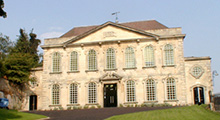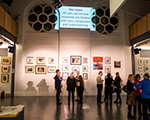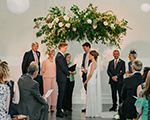Aliceson Carter is a contemporary artist based in London. She graduated from Goldsmiths College in 2009 with a degree in Fine Art. She has exhibited all over the country and taken up a number of residencies. I caught up with her to ask her a few questions about her recent major project ‘Kodachrome’.
What drew you to documenting the end of Kodachrome? Did you use Kodachrome film previous to starting this project?
I had been given some expired kodachrome film by my cousin, who used to be a professional photographer; I felt honoured to be given this gift and viewed the rolls of film as a kind of treasure. So yes, I used it in previous art works, in small peephole boxes containing portraits lit from behind, also a project in 2010 in Berlin, photographing the border of the 1980’s with the expired film from the same era. For this project I had to resort to ebay due to the amount of film required, though I did save my ‘treasured’ film for the trip to Dwayne’s.
What made you decide to travel to America as part of this project?
When I found out that Kodak were going to stop processing the film I had a really strong urge to do something, there was an urgency about it too, it did overtake my thoughts and at times it did feel like a madness. My initial idea was to convince Flickr users to photograph the 23 addresses on the processing packet that used to process Kodachrome, but then as the project progressed it became important to go to the location of the only lab actually processing the film, it made sense. However, it did not make sense logistically or financially, but I could not not do it.
Your Kodachrome project involved working with people in different countries who you had never met, and relying on them to send you images. Did you find it easy to collaborate in this way?
Well, it was exciting in the sense of being remote from them, being a complete stranger making a strange request and relying on them to participate. There were vague shooting instructions which were mainly followed. I also had to rely on the postal services, and obviously a deadline which did cause me some panic. In the end I had to learn to let go of it really, it was part of the process I suppose. There was a lot of anticipation when the slides arrived, and my heart beat slightly faster. In the beginning I was worried about how all the images would all work together but that slowly eased. In the end, two films had to be processed as black and white as we missed the Dwayne’s deadline. One of those films turned out to be blank too, which at the time I found out I thought was a complete disaster, but it actually illustrates the reason /context of the project really well.
Did you give any specific directions to the photographers who took images of the labs near them – for example composition instructions or the time of day to take the photographs?
I asked for the door of the building or the P.O Box to be in the centre of the shot and to take about 5 photos, the rest of the film they could shoot what they wanted. They then had to post the roll of film to the Kodak address in Switzerland (Kodak then sent the film onto Dwayne’s, Dwayne’s then sent it to me, so some of the film travelled thousands of miles).
Do you think there is sufficient demand for Kodachrome that the chemicals will start to be produced again like the Impossible Project did with Polaroid?
I really do not think so, the process was extremely long-winded. There were 14 steps to the development process, and the chemicals are environmentally un-friendly. Plus Kodak does not make the film anymore so there would be a limited need for it. I don’t suppose there are that many un-developed rolls lying around in fridges!
You use a lot of photography and video in your work, do you ever work with other mediums?
Hmm, it is mostly lens based, though I have done installations – mainly with found objects. I did start out as a painter and have dallied with etching.
How would this project be different if you were coming from a traditional photography background, as opposed to your contemporary fine art background?
Oh my, good question. I suppose I might have required more control and have been more concerned with the quality of images, or the technical aspects. I have no idea if the images are at the right exposure for example. I think I was more interested in the idea of the online community showing their love for something that was about to die, the digital and the analogue, connecting different parts of the world via post and email, paying homage, the process of it all, perhaps that would have been a secondary thing if I was a ‘photographer’?
How important is process to you? With your Kodachrome project it seemed as if the process was more important than the outcome.
Yes. Not at the beginning though. At the start I had an outcome in my sights but after all the emails, waiting sometimes weeks for a reply, sending out film that didn’t arrive and just being at the mercy of so many outside elements I just slowly realised that the process was the important thing and I had to just go with it.
On your website you use very little text, leaving the images from the projects to stand alone. Do you feel that photography helps artists to avoid long justifications for conceptual artworks?
I personally feel that I do not want to commit the viewer to anything other than their thoughts, I don’t think it is useful to have a long waffly artist statement, the work (hopefully) should communicate the artists ideas. I do blog, that’s where a lot of waffle happens; I feel it’s safer in a blog format. I do think that there is the slight problem of losing something with all works on the internet, it is documentation, and it’s not the work itself. It’s the modern version of a work of art on a postcard. Most of the videos I have ‘up’ are not made to be viewed on a computer screen; they are projections and installation based. The unboxing film I have, on purpose, not put on Vimeo or linked to Youtube, I have just included the address. I felt it was important to the context. I think most artists (or maybe just me) do not enjoy pinning down their work/practice in words. I don’t know if it serves a useful purpose, it then feels like it is ring-fenced and has little room for manoeuvre.
Aliceson will be giving a talk and showing a film about her Kodachrome project at Rook Lane Chapel on Wednesday 28th November at 7pm. This is part of the Royal Photographic Society Exhibition and Events at Rook Lane Arts.
Join the facebook event for Aliceson’s talk here:
Follow us on twitter @rooklaneartsrps





